
Sitting by a lake in Muskoka in the middle of summer 2019 I decided maybe it was time for an in depth look at the studio works from the Canadian band Rheostatics. Then I thought hey I should rank them so that fans can argue about why I'm wrong. That's the thing about this band, though, they have so many great albums it is not surprising people's opinions on what their personal ranking would be varies so greatly. With 11 studio albums over 17 years there is a lot of material to consider. And where better to consider it than in the beauty of the Canadian outdoors. Actually, I was inside but lovely surroundings, nevertheless.
Briefly the band formed in the late 1970s and released their first new wave inspired single My Generation/Satellite Dancing in 1982. The core trio of Dave Clark on Drums, Dave Bidini on guitar and vocals and Tim Vesely on bass and vocals forged their sound in and around Toronto adding a brass section called The Trans Canada Soul Patrol for a couple years in the mid 80s before jettisoning them and adding their magic weapon in the form of Martin Tielli, guitar virtuoso and a voice like no other. They played back and forth and back across the country and in 1987 recorded their first album Greatest Hits. Then the broke up for the first time. Then they got back together for the first time and teamed up with producer Michael Phillip Wojewoda to record Melville, followed by Whale Music. In 1994 they recorded the soundtrack to the yet to be filmed movie Whale Music quickly followed by Introducing Happiness. Then Dave Clark left the band and was replaced by Don Kerr. This iteration of the band recorded the albums Music Inspired By The Group Of 7, The Blue Hysteria, The Nightlines Sessions, The Story Of Harmelodia and Night Of The Shooting Stars between 1995 and 2001 at which point Don left the band. Michael Wojewoda who had worked on almost all of their albums and a musician himself stepped in to fill the drumming void and recorded the album 2067 in 2004. Then the band broke up for the second time in 2007. Eight years later they got back together for the second time. Don played drums with them again for a couple years but having his own band Communism to focus on he decided to move on and back into the fold came original drummer Dave Clark. Kevin Hearn and Hugh Marsh were also added as members of the band as of 2015.
It is now the middle of 2019 and after several years writing and playing the odd show the band has recorded their 12th studio album Here Come The Wolves due out September 6 2019. So, what better time to review their catalog than now? Incidentally I did not include any live albums in this list of which there are actually 5 (Double Live, The Whale Music Concert 1992, Calling Out The Chords Vol 1, Green Sprouts Music Week 1993 and Brave New Waves). I figured live albums would muddy the water. That being said their 1997 live compilation album Double Live is considered by many fans to be not only the best thing the band has ever put out but also one of the best live albums by any band. It was compiled by Don Kerr from shows throughout 1997 while touring across Canada with The Tragically Hip as well as their own tour in support of their Blue Hysteria album. I would not be forgiven by fans if I didn't mention just how incredible this album is so check it out if you've never heard it. It is a great entry point for the band and really showcases not only why they are great songwriters but also why many consider them the best live band they've ever seen. If you've never heard of the band Rheostatics then I'd have to wager a guess you were googling rheostats for a science project and ended up here. If that is the case I highly recommend you read on as it might just change your life. And yes, the band derived its name from the word rheostat. If you are a fan you probably already knew that. (PDF Version)
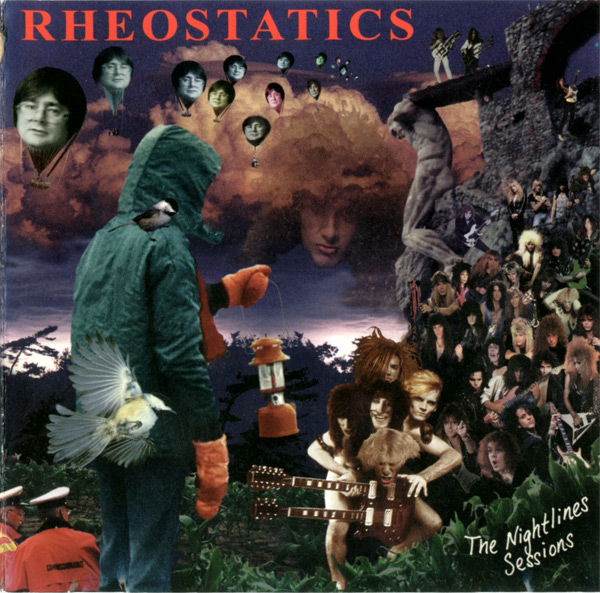
Not so much an album in the traditional sense. The Nightlines Sessions is a recording the band did specifically for host Dave Wisdom who had originally wanted the band to be the show's premier guest back in 1993. It is almost like an Odds and Sods kind of release bridging many years of the band. Some older like Ugly Manhattan and Stolen Car, while others were more recent songs, such as Junction Foil Ball which would reappear 5 years later on the 2001 Night Of The Shooting Stars album. Scattered throughout is the band at their most humorous and silly which is saying something for a band that turned live musical banter into its own genre. There are some cute, catchy songs like The Pooby Song, Majorca and Don't Say Goodnight all of which featured in live sets at the time, as well as more bizarre material such as This Is Nightlines, Alien Boy (which I'm sure has its roots in Tim and Martin's long lost comedy album), and Henry's Musical Beard. As far as I can tell Henry's Musical Beard was played one time 'live 18 years later at the Art Gallery Of Ontario at the request of Tim's son. Trans Jam features Farm Fresh. Frank is beloved to many, with a bridge that would be resurrected in Popopolis from The Story of Harmelodia, and Baby I Love You is either Martin's most loving song or his biggest slice of musical sarcasm...you never know with Martin. Even at the bottom of my list this album still has a few glorious songs despite being the most disparate and strange album in their catalog. Dave Bidini's Stolen Car, which is sung by Martin, still opens many live shows to this day and is still considered by many to be one of their finest songs. It was actually written the night the Rheos performed The National Anthem at Maple Leaf Gardens November 26 1992. Apart from perhaps Stolen Car, most of the album is good or interesting but far from seminal material.
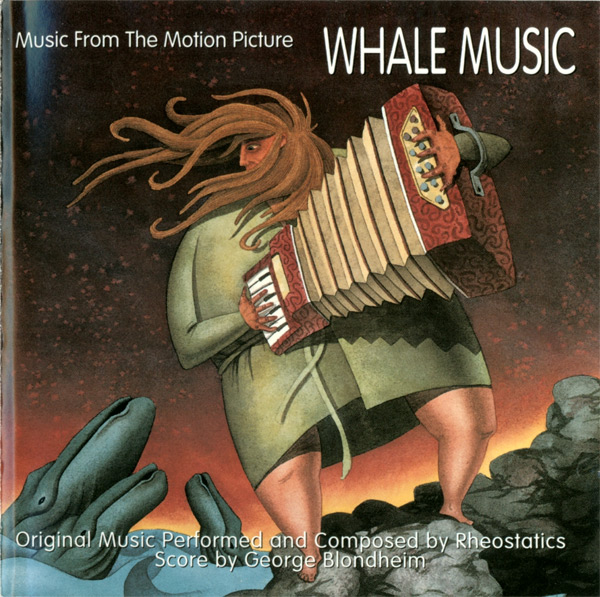
As the band were preparing material for the album that would become Introducing Happiness, they were offered the opportunity to write music for the movie Whale Music written by Paul Quarrington and who's book the band had named their previous album after. The band utilized some original material along with parts of their Whale Music album and yet to be recorded songs. With only a screenplay as reference they recorded the soundtrack to a movie that had yet to be made. But somehow the material ended up being a perfect meld for the Brian Wilsonesque story. Tim penned two songs with the intention of them fitting the story, Torque Torque and Claire which would also make its way onto the follow up album Introducing Happiness. Song of Congregation was drawn from Onilley's Strange Dream and Song of Courtship from Jesus Was Once A Teenager Too (from the then forthcoming Introducing Happiness album) while Song of Sadness inspired by Self Serve Gas Station from Whale Music. Song of Flight/Find Me Mookie Saunders would continue to be a much-loved fan favourite at live shows. To date Claire is the band's biggest radio hit and it is well represented on the album in several forms despite the fact that it was the Introducing Happiness version that ended up on the radio. Check out Song of Danger for some truly amazing vocal harmonies by the band. To my ears it is the best song on the album...weird, beautiful, simple and complex all at once. So even at number 10, for me this is still a pretty solid and ambitious undertaking and one of the reasons I love the band...they were always willing to take risks on new ventures and writing a movie soundtrack is certainly not something most bands have the opportunity to do, let alone pushing out the recording of a studio album to do so. That being said perhaps this gave the band some extra time to try to flesh out what exactly the follow up studio album to Whale Music would become...as it was probably the most productive writing period in the band's history and they could easily have released one or two other albums of material from this period. Still one of my all-time favourite movie soundtracks. Go watch the movie if you haven't seen it...just for Maury Chaykin's performance alone.
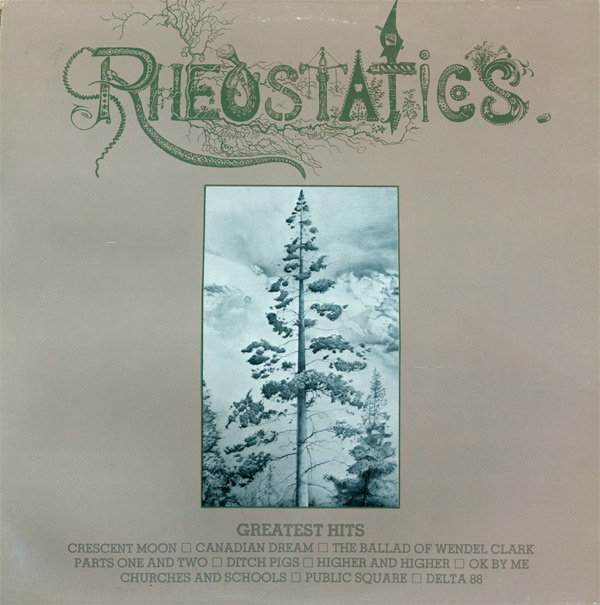
Despite the misleading title this is not a Greatest Hits album though to this day there are probably people who unknowingly buy it thinking it is. It is more reflective of the either the band's anti-rock band nature...or overstated bravado, calling their first album Greatest Hits. Actually, I'm pretty sure it is humour - if you read the liner notes it is clear they were trying, even at this embryonic recording stage, not to take themselves too seriously. Humour has always been a key part of the band's music and live shows and on record it started right here at the beginning. The album, like all others, has contributions from Vesely, Bidini and Tielli and showcases even this early in their career, their keen sense of vocal harmony and texturing. What is missing is the iconic sounds of Martin's guitar and more focused writing that would follow. The other major setback for the album is the fact that the production is pretty tinny and has way too much reverb for my liking. I'd love to hear a remixed version of this album. The songs are solid but again this is early stages of their development as the founding foursome, with Martin having joined the band not long before this album was made. He actually painted the cover art after his 10th live show with the band. Standouts on the album are the still (infrequently) played Ballad of Wendel Clark Parts I and II, Crescent Moon (the first of many songs written by Bidini but given to other members to sing), Public Square and Ditch Pigs. For me the most interesting thing about this record isn't what is on it but what was left off. Material which could have been used for this album was actually held back for later releases in songs such as Dope Fiends and Boozehounds, Stolen Car, Northern Wish, Christopher, Lying's Wrong, and King of The Past. It would be another 4 years and one break up before the band really came together on record to produce some of their most iconic material.
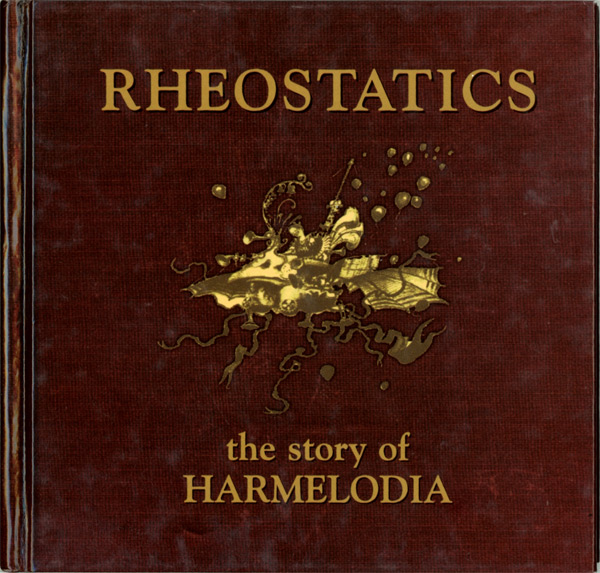
This is a bit of a complicated beast. A prog/pop/punk/alt rock band doing a children's album with full story book included and written/recorded as such. Some people have a hard time with this album, but man is it ever ambitious. Having already recorded four standard studio albums, one movie soundtrack, a National Gallery funded/inspired record about the Group Of Seven and a semi-serious CBC Nightlines swan song release, the band again changed directions and immersed themselves in a strange, musical, sort of creepy children's story somewhere between a Grimm's fairy tale and the Wizard of Oz featuring some questionable parenting skills. Strange names and places like Drumstein and Popopolis with Wingophones and Monkeybirds (or Monkey Bird depending if you look at the cover or the insert). This album took forever to actually record having a vast number of guest musicians including Kevin Hearn, Ben Gunning, Sarah Harmer, Dave Merritt, Mia Sheard, Kurt Swinghammer to name a few, plus flute and a four-part string section. Narration was done by Janet Morassutti, Dave Bidini's wife. The band members also included Kevin Hearn and Michael Wojewoda who produced as well. This was Don Kerr's fourth of five albums as drummer for the band following Dave Clark's departure in 1994. If you can overlook some of the inconsistencies in the story itself and just kind of go with it, it is a pretty great ride through some quite varied musical terrain. Several songs borrow from kids tunes such as The Harmelodian Anthem (The More We Get Together) and Monkey Bird (lifting its melody from Yellow Bird). There are some straightforward pop songs such as I Fab Thee, It's Easy To Be With You and Loving Arms. There are kid like romps such as Song Of The Garden and then there is some awesomely weird stuff like Wingophone and The Bee Sky Opus In Magenta. Tim Vesely has a beautiful hidden gem in Invisible Stairs as does Martin in Home Again. Even Don Kerr sings a couple of songs - Father's Sad Song which many may not realize has lyrics by Gord Downie, and also The Sky Dreamed - another song Bidini gave away for somene else to sing. This may not be the best entry point for new fans but by the same token a lot of the material on its own is pretty friendly terrain and not nearly as heady as some of the bands more epic material. If you are someone who this album doesn't quite click with I'd suggest sitting down with a good set of cans and really listen to this album. It is lush and beautifully recorded, has a gorgeous book painted by Martin Tielli and Matt James, and even has an intermission half way through the CD .... as if it were a record. Somehow The Tea Party beat out this album for Best Album Design which is mind-numbingly shocking. I mean the CD came in a custom-made book. It also failed to be nominated for Children's album...all I know is my kids loved it and so did I. Again, the fact that the band did this kind of album is part of what makes them so unique and special and maybe also why they have been so difficult to pin down to a particular genre - they just make music...all kinds of amazing music.
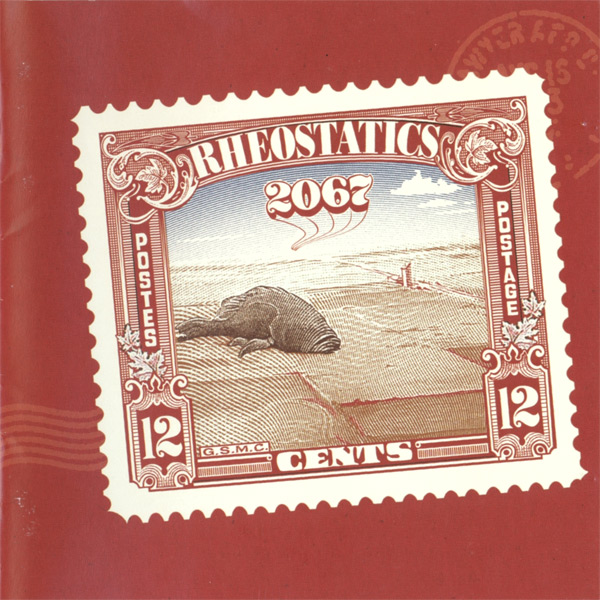
This album seems to split fans. Some put it near the top of their list of best Rheos albums and others near the bottom. For me it is just outside the middle. It may have something to do with when your entry point was with the band and I'm thinking those who put it near the top are probably ones who got into the band at a much later stage than the ones who would place it in the middle or bottom of their list. The band was nearing the end of their time together (the first "final" show was March 31 2007 at Massey Hall but they had basically broken up in 2006) and it kind of shows. Martin contributed just three songs to the record. The wonderful opening track Shack In The Cornfields which is almost a predecessor of his Ghost of Danny G albums, The self-mocking and angry The Latest Attempt On Your Life, and the one single from the album, The Tarleks, which despite everyone always pigeonholing Martin's writing as progressive and epic in nature, shows yet again how able he is at writing great catchy rock/pop songs. It also featured a great video with Herb Tarlek himself, Frank Bonner. Dave Bidini has 5 songs on the album. For me the one main issue I have with the album is that three of them are just OK in my opinion. I Dig Music, Power Ballad for Ozzy Osbourne and Polar Bears and Trees just don't really resonate with me as much as most other Bidini material (sorry Dave). On the other hand, Little Bird, Little Bird and Try To Praise This Mutilated World are two of my all-time favourite Bidini songs so it is a bit of a trade-off. For me Tim is the star of this album. I don't know what was in his water at the time, but his three songs are all awesome (that being said Tim's songs are usually great). I think he might have been channeling his inner Fripp. Marginalized and Here Comes the Image are both proggy masterpieces and Making Progress is simply one of the best songs he has ever written. I used to listen to Making Progress repeatedly when the band was splitting up and I was very very happy they played it at Massey Hall. Michael Wojewoda produced the album and it was the only one he was the official drummer on, following Don Kerr's departure in 2001. Michael also contributed the instrumental Who Is This Man And Why Is He Laughing?. The final song on the album is actually a hidden track - a futuristic synth version of Record Body Count which originally appeared as the lead-off song from the Melville album in 1991. It is quirky but fantastic. I believe Tim actually recorded the entire thing himself including vocals. It reminds me of something Tim Vebron and Rheostar would have done - the alter ego band the Rheos would occasionally appear as, dressed in full wigs and capes and looking like wizards with instruments. Apparently 2067 is a bit of a concept album about the Canada at its 200th anniversary in 2067...I'm not sure if it is or not. Maybe someone can explain it to me. Either way it is an album that for me has some super amazing highlights but in the end has a few songs I just don't love the way I love other Rheos material and it doesn't gel for me as well as some of the other albums on the list. Don't get me wrong, though, it is still a great album.
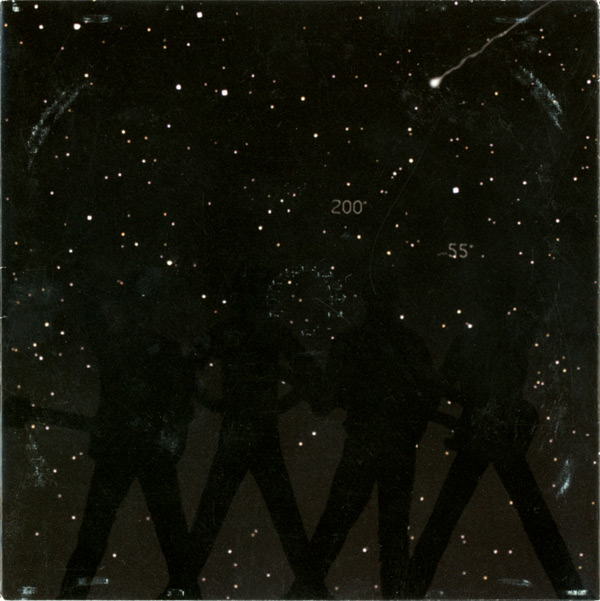
This album tends to be pretty high on many people's list of favourite Rheos albums and it is easy to understand why. It is a big bold sounding rock album and was the first "traditional" studio album from the band since The Blue Hysteria 5 years earlier. Guns a blazing from the first track, These Days Are Good For The Conservative Youth Party Alliance (aka CCYPA) is both one of the strongest lead off songs from any Rheostatics album and is also the longest title in their catalog. It is both scathing and funny with lines such as "There's a Lenny in my Kravitz that must be removed" and "I chipped my eye tooth on the back of a urinal". I don't know what they mean but they are definitely memorable. Martin appears to be much more involved in this album than he appeared to be on the preceding Harmelodia album and 2067 which followed. I'm guessing he was less engaged in Harmelodia and was more energized by a more traditional album. Everything from him on this album is pretty great including Junction Foil Ball (previously heard on The Nightlines Sessions but rerecorded for this album and apparently about a guy in The Junction in Toronto who was building a giant foil ball from cigarette package foil lining), The Reward, and the epic Satan Is The Whistler which namechecks his brother's band People From Earth. I'm not sure anyone other than Martin has any idea what this song is actually about. Finally, from Martin is P.I.N. which is one of his greatest pop songs and it is beyond my comprehension how this song was not a huge hit single - it even had a fantastic video. In case anyone was wondering, Michael Wojewoda is in the video as Don Kerr had left the band just following the album's release and Michael took over on drums. It is also why Don can be seen walking away from the other three band members on the back cover art. Dave on the other hand seems to have less writing involvement on this record and again perhaps due to the fact that he was so central to Harmelodia. Mumbletypeg is another later period gem from Dave's never-ending bag of tricks and one of only two songs from this album played live since the band reformed in 2015. Tim also has a couple classic songs on this album in the form of Superdifficult and Remain Calm.
The reason this album doesn't rate higher for me comes down to the fact that I feel like it kind of sags a bit half way through. We Went West is a good solid first Canadian tour memoir but is a bit repetitive - actually when it was first played live it was almost 9 minutes long and had additional verses that were dropped for the record. The Fire has a co-writing credit to Dave and Martin but it feels like it needed a bit more time to germinate from a good to a great song. In It Now and Here To There To You are both fine but for me not really as memorable, nor are they songs I seek out to hear. Originally the album was in the hands of Ian Blurton but there were some challenges with that partnership and ultimately Alun Piggins stepped in to complete production with Michael Wojewoda doing the final mix. Overall the album is a bit more rockish than their other albums - a little more straight shooting and not as quirky or heady but it is a super strong album regardless, even if the band were not really breaking any new ground. I don't like to criticize any artwork from Martin but this is the one that I feel needed a bit more time (sorry Martin) - it is fine - it just isn't amazing and most of Martin's artwork is amazing (FYI if you were unaware Martin has done the artwork for all the Rheos albums and considers himself a painter above musician).
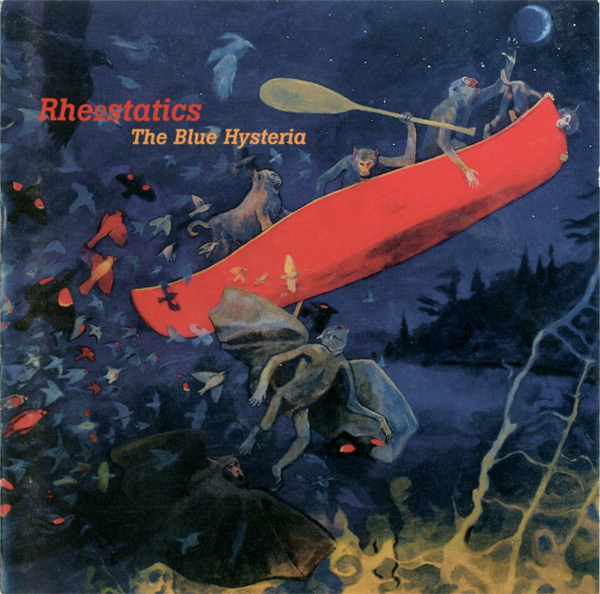
Rheostatics 7th album and second with Don Kerr on drums followed quickly on the heels of the Group Of 7 album. I'm not sure how many bands produce such definitive material 7 albums into their career but here it is. This one actually places at the top of many fans' lists probably in part due to the fact that the band was touring with The Tragically Hip on their 1996 Canadian Trouble At The Henhouse tour, so it exposed them to a much broader audience. The fact that the singles All The Same Eyes and the Mike Harris (Ontario Premier) bashing Bad Time To Be Poor (both by Tim) got a fair amount of radio play as well certainly helped. That being said there is so much greatness on this album it is not surprising it is such a fan favourite. The other two Tim songs are An Offer which is pure Vesely magical beauty and almost gets overlooked on an album of giant songs, and Connecting Flights, which has the distinction of being my least favourite Rheos song (sorry Tim). Don has one song (just like Ringo). Unfortunately, Never Forget is also on my short list of least favourite Rheos songs (sorry Don). Dave Bidini's contributions are all pretty stellar. Fat and Feed Yourself are both monster songs which never really left their live show rotation up until Dave Clark's return in 2016. Both are/were epic live, and I used to think Don Kerr's drums might actually explode when he played these tunes. Four Little Songs is a crazy melding of...well four songs. Once at a Rheos show at Ted's Wrecking Yard in Toronto around 1999 I was talking to Gord Downie of The Tragically Hip who was just there...in the crowd...watching the band...and he turned to me and said "It blows my mind that bands can write songs like this". You got that one right Sister Butterfly. Martin Tielli contributed four amazing songs to The Blue Hysteria. Motorino is the most straight forward despite being infused with Italian. I have no idea what it is about, but it is fun to sing the word Motorino in a song. The Idiot is a bit of 60s trippyish infused rock. I'm not sure what this song is about either, but it is definitely something different from Martinville. Sweet, Rich, Beautiful, Mine is one of Martin's greatest epic songs. He duets with former girlfriend Tamara Williamson on this one and manages to hit the single highest vocal note in the band's entire catalog. It is an eerie and gorgeous song which just builds and drops and builds to a huge crescendo ending. You have got to hear it to believe it. Mariah Carey would be proud. The last song on the album is arguably the greatest song Martin contributed to the Rheostatics. A Mid Winter Night's Dream is simply awe inspiring. It is quiet and gentle with his guitar mimicking the vocal line in the first three minutes before the band kicks in and builds for the following three minutes. Then it all drops out and just floats away for another couple minutes. Lyrically it is taken from a dream Martin had. It is like free form poetry. There is no chorus and I'm not even sure there are verses, but it is so so SO incredible. The finest version of this song I've ever heard is the first song on the second CD of their Double Live release. It is breathtaking. If you don't like this song, we can't be friends. Period. After a short two minutes of silence the album ends again with the hidden track My First Rock Concert, which is Bidini's campfire homage to the love of rock and roll and for those who were there, it featured beautifully at the 2007 Massey Hall "final" show - the song referencing the venue itself. It was a great moment not lost on the crowd.
Like the remaining four albums on this ranking, this record could easily be up there for me as well. Some days it is. There is so much awesomeness on this album. Incidentally the song The Blue Hysteria appears on the Group Of Seven album.
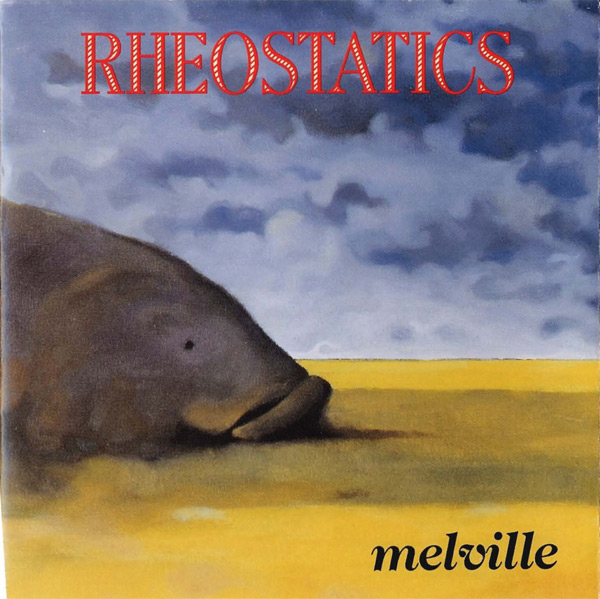
If you ever want to get the attention of a nation, kick off your album with a song about a depressed high school student who can run fast in the woods and ends up hanging himself. It worked for Rheostatics. At one minute and 55 seconds it is a perfect Martin Teilli pop song which got quite a bit of college radio airplay back in 1991 and really put the band on the map...a map...a musicians' map of Canada...it is also one of the shortest proper songs in their catalog. Everyone loves it and it actually inspired two follow up songs (The Royal Albert and Joey III - neither of which ended up on a studio album). It is hard to understate just how central to the mythology of the band the material from this album is. It is like a road map of Canadian music and although only their second album, could in fact double as a Greatest Hits album despite the name already being used for the previous record. Martin sings lead on six of the first eight songs. Aliens (1988) is a great song which allows for people to sing along to both the words "underwear" and "tits" and it has a musical tag stolen from Take Off by Bob and Doug Mackenzie. Northern Wish is sung by Martin but was written by Dave and his wife Janet. It is my all-time favourite Rheostatics song and I would get behind anyone who wants to lobby for it to be used as a replacement for the Canadian National Anthem. It is a beautiful BEAUTIFUL song and I am forever grateful that Dave wrote it. Northern Wish is followed with possibly my second favourite Rheos song in Saskatchewan - co-written by Dave and Martin. If I had to pick one song that defines the band, it would probably be this one. It is also the lead off song from their Double Live album and again like, A Mid Winter Night's Dream, is possibly the best version of it I've ever heard. Saskatchewan is THE song that turned me into a Rheostatics fan. It was the first song they played at The Horseshoe Tavern at a show back around 1996. It wasn't my first Rheos show but it was pretty close to it and that moment something snapped in my brain and they have been one of my all-time favourite bands since then. Next up is Horses which is again one of the band's most revered songs and possibly one of the best ones Dave Bidini ever wrote. It is an absolute monster live. Some Rheos shows build up over hours to this song specifically. Holy Mackinaw Joe indeed. Plus, Martin makes his guitar sound like screaming horses at the end. It is something everyone should hear and see at least once but preferably many times. Then comes one of Martin's most gentle songs. Christopher is a deeply personal song but I'm not sure why. All I know is that it builds to a point where you are left feeling like weeping or just plain exhausted. It sounds like desperation. It also showcases just how amazingly the band can do both the most riotous and purely delicate all within the same song. Chanson Les Ruelles is the only song on the album written solely by Tim - it is OK but to me actually feels somewhat out of place in the context of the other material. Lying's Wrong follows and was co-written by Tim and Martin - possibly the only song they have co-writing credits on. It is the one song on the album that kind of sounds like it would not be out of place on Greatest Hits as it is more straightforward in style and execution. Good but not amazing. Then comes "It" which is also one of my favourites from Tielli. It is an absolutely beautiful song that to me is the equivalent of what the best memories of childhood would sound like if they were turned into music. I also love the fact that two of my favourite bands both have songs called "It" and I know of no others. The Bidini epic When Winter Comes follows (it was originally called Epik on early setlists) and is another Bidini/Tielli co-vocal offering which has always been a live favourite. One of the most memorable moments from the Massey Hall final show in 2007 came during the ending portion...the blue Canadian winter section which was written in a hostel in Dublin Ireland...when they managed to make it look like it was snowing inside Massey Hall and Tim just swayed in circles lost in the moment and looking like he wasn't really going to be able to hold it together. It was transcendent and it brought many people to tears. Last up is a Tim Vesely sung cover of Gordon Lightfoot's The Wreck of The Edmund Fitzgerald which the band, even to this day, will pull out on the odd occasion, dim the lights and just drag everyone into its eerie depths. One of the finer cover songs out there and one of only a couple they ever recorded for a studio album, but it fits in perfectly. It is followed by the lullaby You Are Very Star and then something along the lines of a Rheostatics Hockey post game show.
Melville is possibly the most "Canadian" album ever recorded. Not in a bravado, we are the best country in the world kind of way, but more like a musical tapestry of what Canada feels like. Not surprising, as the album had its roots in the bands cross Canada tours riding and sleeping in vans and on couches in cities and towns across the nation.
So why would I only put this album at number 4 on my list? It is a good question and not easy to answer but I think it comes down to the fact that the production and sounds the band was working with at the time just didn't quite capture what I think this album could have been. I mean it is one of the best albums ever to come out of our country, but I think where they would go with these songs in the live setting, the instrumentation and cadence of the songs, went so much further than the album itself reveals. To me it carries just a slight degree of hesitancy to the sound and I wonder how it would have sounded if they had recorded it after Whale Music. I'm splitting hairs here at this point because any of these top 5 albums on my list could just as easily be number one as well. That's how good they all are.

Prior to the recording of this album the Rheostatics signed their only major label record deal with Sire records. Following the Whale Music album, they had managed to write a huge amount of material. I would venture enough for at least two full albums based on demos and live outings from this era. Much of the material that would end up on the album was showcased at the band's first ever residency at the now defunct Ultrasound Showbar on Queen Street in Toronto in April of 1993 for their inaugural and subsequently almost annual Green Sprouts Music Week, which would last anywhere from 4-14 days. Shortly after the first GSMW the band was offered the opportunity to do the Whale Music soundtrack and following the signing with Sire they were provided with a recording budget that allowed for them to relocate to the Bahamas to record. As such Introducing Happiness has a very laid-back tropical summer kind of vibe to it. Even the cover is reflective of the tropical nature of the recording environment. It is a huge and extremely diverse sounding album that explodes with ambition at every turn. I equate it to the White Album of the Rheos catalog and as with the previous two releases, was produced and engineered by their own George Martin in the guise of Michael Phillip Wojewoda.
The album is really all over the musical map and may seem disparate to some but as a whole the album somehow fits together and flows gloriously. The live favourite and still played to this day Bidini classic, Fan Letter To Michael Jackson, opens the album with a childlike fanclub innocence mixed with various bleeps and squeaks until it finally peaks with the line "It Feels Good To Be Alive" with Martin's sustained vocal ending. It is pretty awesome every single time even after many years and many listens. The title track follows which is again one of three excellent Tim songs on the album and oddly enough about his cat. Read the lyrics and say "aaahh of course". It would seem fitting as he wrote about a dog on the previous record. Claire was the band's big hit single and contains an awesome guitar solo by Martin. Row is the other great Tim offering and is quite a moving, emotional allegory to war. The other song Tim contributed to the album is The Woods Are Full Of Cuckoos which was something he originally wrote for Dave and Janet's wedding titled The Wedding Song. Dave rewrote the lyrics with the title a nod to the early 80s band of the same name that eventually morphed into the band The Lawn. Bidini seemed to channel his inner weirdness on Earth/Monstrous Hummingbirds and Cephallus Worm/Uncle Henry (co written with Martin) and delivered one of his best pop songs in Me and Stupid which bares resemblance in style to Mumbletypeg from the Shooting Stars album. It also has a great little break in it where they mention "traditional new wave rock" and then samples a song the band worked on in the 1980s called Elevator which never ended up leaving the demo stage. Dave also gifted the lead vocals of Jesus Was Once A Teenager Too to Martin - something Dave has done many many times with his songs, always wanting to best serve the song and not the ego. It is a rare thing to give away songs for others to sing when you are in a band, but it is something that also makes the Rheos such a unique entity. That being said there is a Demo version of Dave singing this song and he made the right choice having Martin sing it. Martin's songs on this album are numerous and extremely varied. Digital Beach and In This Town deftly channel his inner Neil Young (and take some liberties as well), Take Me In Your Hand is a gentle and beautifully delicate song often played unmic'd from the middle of the audience as an encore, Fish Tailin' an ode to why Martin doesn't drive a car and You Are A Treasure which feels like a song created while recording the album in the tropics. The closing song is Onilley's Strange Dream aka Saskatchwan Part 2 and was also co-written by Dave and Martin. After Melville the band had the idea to record an album where every song was a continuation of songs from Melville and the album would be called Melville Part 2. The two songs that came out of this idea were The Royal Albert (Joey Part II) as the second part of Record Body Count, and this song which was the continuation of the story of Saskatchewan. It is another epic album ender, both odd and wonderful, and references "the Caroline from the other song". I love every single thing about this song and like it's forebearer is also one of those songs that kind of defines the band at its best. It also contains my all-time favourite Rheos lyric in the cannibal reference "Chicken Jimmy kept me alive though he wasn't much for conversation" - FYI the Jim being referenced was Jim Creeggan from Barenaked Ladies. I also love how the title comes from the line "my name is Onilley McNoan - to me". Elsewhere on the album is the Caribbean infused nod to Roberto Alomar in the song Alomar. Dave Clark plays his Ringo card with Full Moon Over Russia, similar in vibe to the song Guns which he contributed to Whale Music and there is also a wicked cover of Jane Sibbery's One More Colour sung by Martin.
So yeah this album is all over the place but it is gloriously ambitious in scope and execution. More so than any other album they have made in my opinion. It is performed and recorded impeccably and showcases everything that is great about the band with all top shelf material, as it was drawn from such a vast wealth of songs they were working with at the time, most of which never ended up on studio albums. I would love to see this album reissued with a full album of additional material demo'd but not used because it is equally impressive what wasn't used as what ended up on the album. It was also the last album with Dave Clark on drums.... that is until Here Come The Wolves...
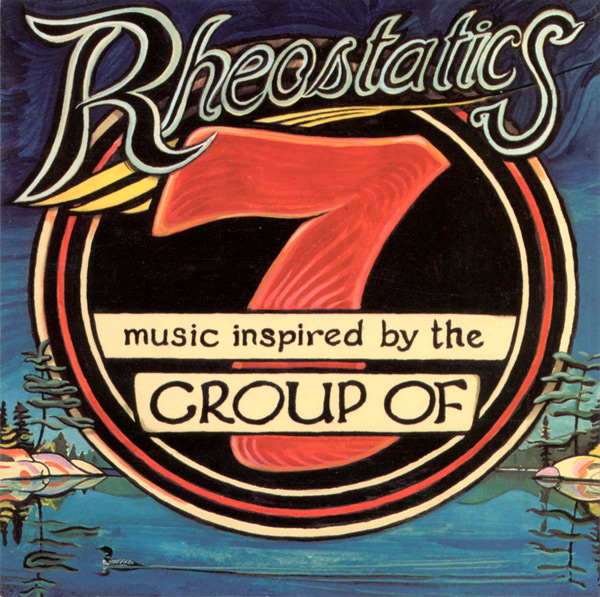
If you wanted to describe in music what Canada looks and feels like once you leave any populated area this is as close as I think you could get to it. Music Inspired by the Group Of 7 is exactly that. It isn't art put to music - it is the effect of taking masterful Canadian landscape art and using it as a springboard to try to articulate what exactly Canada as a natural work of beauty might sound like. Just as the Rheos were dealing with the loss of founding member and drummer Dave Clark and breaking in Don Kerr while demoing material for what would become the Blue Hysteria album, the National Gallery in Ottawa commissioned the Rheos to do a concert of original material based around the 75th anniversary of the Group Of Seven; a collective of artists who were some of the first people to really travel out into the wilderness of Canada and capture on canvas the beauty that many had never really had the opportunity to see. The land that is our country but hidden to most without access. The band accompanied by Kevin Hearn for the first time as official band member put The Blue Hysteria to the side and worked up what Tim Vesely once described as "just a bunch of stoner jams" into a 40 minute suite of mostly instrumental music and performed it 6 times to an accompanying set of slides related to the Group of Seven and Canadian Landscape imagery. Two shows each in Ottawa and Toronto with Kevin Hearn and two shows in Vancouver with Bob Wiseman. They could have left it at that but instead they decided to record the whole thing as a proper studio album accompanied by interview segments by Winchell Price and historical spoken recordings from Queen Elizabeth, Mackenzie King, John Diefenbaker and Lalonde. Originally the songs were titled One through Twelve but have since taken on additional titles.
The album starts with Kevin's Waltz with the sound of rain and a voice over that describes the similarity between how the key in a musical composition is comparable to the mother colour in a painting that binds the composition together and is followed by a short piano section that then becomes its own song at the end of the album. Kevin's Waltz acts as the mother colour of the album. Song Two (Earth (Almost)) to me sounds like the creation of life put to music. Boxcar Song (Weiners and Beans) has a spoken intro that describes how painters often use music for inspiration and then the music morphs into the best train song ever. It sounds like both building the railroad and travelling across the country as a stowaway in a boxcar at the same time. This song would continue to be played many times at their live shows and was often a highlight of any concert it was performed at, much like Song of Flight from the Whale Music Soundtrack. After a short description of landscape and sky comes song Six, The Blue Hysteria, which would end up being the title of their next album. It is a gentle acoustic guitar-based song with piano and cello, and one of only three with proper lyrics on the album. It is a breathtakingly beautiful song. Cello For A Winter's Day follows and it sounds like a crisp sunny cold winter day set to music. When the band performed this material live they would then have a short intermission and the band would be introduced (and Dave would urge people to go pee if they had to). Song Seven is a cello based version of the song Northern Wish which had originally appeared on the Melville album. It is similar in structure yet completely different in execution and is the one song from their catalog that feels like it was written for this album before it even existed. Once in a while the band would perform this version with Don on cello including their "final" Massey Hall show in 2007. A short spoken-word about Snow quickly dissolves into song Nine called Biplanes and Bombs. I don't think the title is reflective of the inspiration of the song. Again, gentle acoustic guitars and single piano notes build into a tapestry of sound. The song should probably be called The Bruised Sky - a phrase Dave mentions in a documentary that Gord Downie once used to describe the look of the sky in the north prior to a storm. That is what this song sounds like to me and it is my favourite song on the record. I cannot for the life of me comprehend how it could have been left off of the vinyl edition of the album (actually it was due to total time being too long for a single album). The song ends with a cacophony of sound and leads into Lightning which was also cut from the vinyl release. This is Rheos doing something approaching indigenous rock approximating the sound of a rain dance and storm. It is the most dissonant song on the album. Finally, is Yellow Days Under A Lemon Sun written by Kevin and a fully realized version of Kevin's Waltz which starts the album. It is a gentle post storm piano and cello based song that has a lullaby kind of feeling - almost Harmelodia-like though three years its junior. It is quite a wonderful ending to the album. There is actually one final track called Bye Bye which is just Don ending his conversation with interviewee Winchell Price.
If you took the almost indescribable beauty of Canada along with all that is dark and scary and thunderous and put it to the most majestic musical soundscape, that to me is what this album is. It is the National Anthem of the beauty of the Canadian landscape in 40 minutes and it is the closest thing I've ever heard in music approximating the essence of the Canadian wilderness. That is one of the reasons why for me this album is so high on my raking of Rheostatics albums. The other reason is that I feel as if this album saved the band...twice. In 1995 they were in a significant period of transition and while they could have just released The Blue Hysteria, a masterful work unto itself, they ended up having to focus on something altogether brand new from scratch which required contributions by all members. I think the focus required to do this really forged the new creative relationship with the original three plus Don. The addition of Kevin who had played with the band previously and to this day still performs with the band also helped broaden their palate. Then 20 years later and 8 years after the band had officially broken up, the Art Gallery of Ontario wanted to celebrate the anniversary of the project and organized a four night performance of the album by the band, accompanied by brand new slides and room enveloping visuals courtesy of Jennifer Baichwal and Nicholas de Pencier who had already made numerous documentaries and would go on to do the visuals for the Tragically Hip's final tour. Dave had first met Nick working on the Hockey Nomad documentary in 2003 which was based on Dave's Tropic of Hockey book. The AGO shows contained some of the most captivating live visuals I've ever seen at a concert. Without these shows in 2015 I don't think the band would have gotten back together. So apart from being a true work of art as a musical achievement, it is also a work that in my mind helped keep the band together in 1995 and helped resurrect them in 2015.
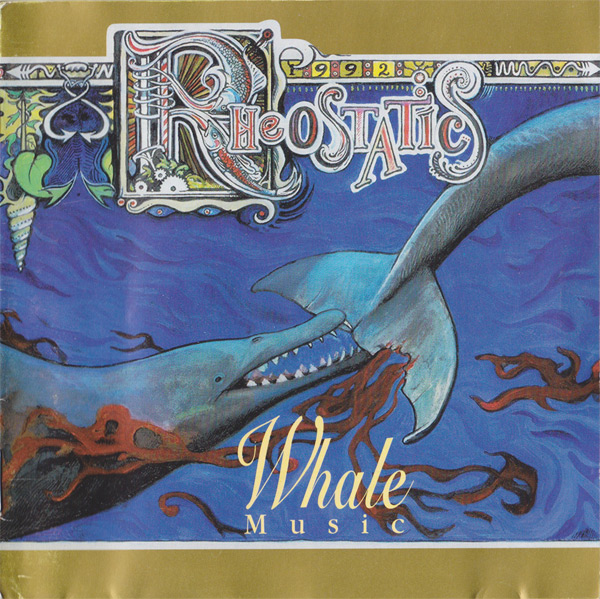
A surprise at number one? Not really. When Chart Magazine conducted a reader's poll in 1996 for the top 100 Canadian albums Whale Music placed fifth and four years later it placed fourth. In Bob Mersereau's 2007 book The Top 100 Canadian Albums it placed nineteenth, so it isn't really a surprise that for me, like so many others, this is their definitive album. That being said I'm sure, like myself, fans could easily place four or five different albums as their top Rheostatics record depending on day or mood. So what makes this album so good? I'm sure everyone has their own reasons. When I first heard Whale Music in 1993 I could barely get through it. My first thought was that I didn't really dig the country thing going on in the opening track and it wasn't until a couple years later when the toured with The Hip and Bad Time To Be Poor was out as a single that I really started to pay attention to what was going on. Upon reinvestigating the album, I quickly realized what I had missed the first time around. Whale Music is a collective Tour-De-Force of production, song writing, musicianship, collaboration, elegance, charm and chaos. Before Broken Social Scene and Arcade Fire there was a collective of Toronto musicians that would show up on each other's albums and live shows. This album is the most cohesive representation of that time. Just looking at the list of guest musicians is enough to impress even the most sceptical critics - apart from Tim Perlich who's review stated "it looks like art if you squint". I don't think he liked it but the band being who they are ended up putting the quote on one of their t-shirts at the time. The list of musicians and instruments includes Dave Allen on strings and violin, The Barenaked Ladies, Joey Bechta on tambourine, Chris Brown on organ, piano and trombone, Richard Burgmann and Matt De Matteo on power tools, Gene Hardy on sax, Tim Martin on accordion, Tim Mech on guitar, Lewis Melville on various stringed instruments, Michael Wojewoda, Tannis Slimmon, Dutch Toko and Neil Peart! Of RUSH! Plus many others adding vocals. It is a massive, vibrant, lush record that really brings together everything the band had in its arsenal plus a whole lot more. Every single song on the album is amazing and beloved by most fans.
So let's take a look at this beast of an album which starts with a trifecta of Tielli songs. Self Serve Gas Station opens the record with sweeping orchestration and then it is a little bit country before building to a lush progish ending with Martin's soaring vocals both gentle and menacing. It is a true story. Martin did at one point work the overnight shift at a gas station. The song dissolves into California Dreamline, another Martin original that was the first ever use of the word Californication years before the Chilli Peppers did. So much drama in the music and production and it is only the second song. As it fades away, we get the clapping intro of Rain Rain Rain, which is feels Caribbean flavoured, similar to Alomar on Introducing Happiness, and infused with a live off the floor vibe. Next up is Bidini's Queer. It. Is. Freaking. Awesome! Not just one of the best songs on the album but one of the best songs the band ever recorded and an anti-anti-LGBT song 20 years before it was on most people's radar. The vocals on this song are outstanding and somehow Dave manages to meld the ultimate fuck you to homophobia in a hockey reference. Chris Brown (of The Bourbon Tabernacle Choir) plays some stellar piano and the song has one of the best outros to a song ever...other than that OTHER song on this album. King of The Past is a lovely Canadiana infused song written by Bidini and again gifted away, this time to Tim. It is another song that ranks way way up at the top of many fan's favourite song list. This one has a great violin solo that morphs into another Martin standout guitar solo. Just incredible stuff. So achingly powerful it is hard to actually articulate. The final bent guitar note of the songs hangs for a good 20 seconds in a way that Neil Young would be proud. And then...Power Tools. How many times have you ever heard power tools used as the lead in to a song? I'm betting zero if you don't know this song or one if you do). Either way it is a pretty freaking awesome sound and RDA (Rock Death America) is probably the highest paced and most aggressive song in the entire Rheos pantheon of music. Two and a half minutes of pure pristine adrenaline rock like no other. Martin's guitar even sounds like power tools. OK...there are two versions of this album out there. One was released in 1992 on Intrepid Records and then after the band signed with Sire it was re-released in 1993. The one difference I'm aware of (apart from the fact that Martin added more blood to the water on the album cover) is at the end of RDA on the original is the sound of the power tools powering back down. On the Sire version and on the reissue in 2010 the power tools don't end the song. If you don't have this version of the album, I highly recommend looking for it. It is a tiny little 5 seconds of sound, but I miss it every time I don't hear it and it bookends the song like a Rust Never Sleeps tune. After the outrageously entertaining RDA is The Headless One by Tim at his weirdest, talking about wearing his head overtop of yours. It might be a metaphor, but I wouldn't know as I suck at metaphor comprehension. Legal Age Life At Variety Store is one of the most fun songs in the bands arsenal of joy. It has been the centre of many a crazy live jam featuring guest musicians, dancers and generally people having way too much fun. Probably Dave Bidini's most successful earworm of a song and a live staple from the day it was released until the day they exit the stage (left). Martin's What's Going On Around Here? comes in at song 9 of the 17 song extravaganza. It has accordion and is a solid Martin song. Then there is Shaved Head. I don't know if I even want to try to articulate this song. I will say this - it is a true story. It is strikingly emotional. It is a song that brings people to tears. I've found myself in such a state many times seeing this song performed. It is the song that the entire album revolves around. It is one of the single most movingly effective pieces of music I've ever heard. The outro is a shimmering masterpiece. Stop reading this and just go listen to it if you've never heard it before. You can thank me later. The rest of you can check out some early live versions for a verse that was dropped for the album version. The live from the floor video is something amazing to behold as well. On Introducing Happiness Tim sang about his cat and here he sings about a dog on Mount Palomar with an owner named Palomar...coincidence? I don't think so...actually I have no idea what this song is really about, but it is a beauty and is one of the many songs that Tim and Martin sing together. I haven't mentioned this previously but the melding of their vocals on a great deal of Rheos songs is one of the rarely mentioned fantastic things about this band that spans their entire catalog. Dave Clark's Ringo Star moment on this album comes in the form of the song Guns. Like the forward-thinking Queer, Guns was years ahead of the firearm obsessed world many live in today. It is basically a poem set to drums. BUT the drums are played by Neil Peart ... OF RUSH......did I mention the drums were played by Neil Peart? Of RUSH? Ok moving on. Originally Martin's Sickening Song was called Only Beginning and it was also in the running for the album title. Another accordion infused tune that has a very Italianisimo kind of feeling with weird time signatures that confuse and excite at the same time. And then there are trumpets and horns. It is an odd tune unlike any other in the Rheos songbook. Soul Glue follows Sickening Song and is probably the oldest song in the band's recorded catalog, having its genesis back in the mid 80s when they were still Rheostatics and The Trans Canada Soul Patrol. The lyrics were different back then, but it is the same song at its core. The story in the revised version of the song is based on the drowning of Benjamin Heyward after the 1992 Pink Floyd concert in Toronto. Beerbash is another rocking Bidini song in the vein of others that would follow like Me and Stupid and Mumbletypeg. It also deftly rips off Dig A Pony by The Beatles. Check it out. You will see what I mean. The penultimate song on the album is Tim's Who? which again features great shared vocals with Dave and Martin. Tim tends to be viewed as less adventurous a songwriter than Dave and Martin but on this album and then on 2067 he proves he can hold his own in left field just as well as the others when he wants to. I love that the last guitar riff and drum beat of the song is taken directly from Jailhouse Rock. Finally, we get to song 17. Yes, there are 17 songs on Whale Music which clocks in at almost an hour and 10 minutes in length. Dope Fiends and Boozehounds is the sister song to Stolen Car. Both were written years before but just like Stolen Car this one was held from inclusion on an album for ages and I'm really glad it was, as the production on it is particularly excellent. It just wouldn't have been as good if they had recorded it for Melville. Dope Fiends is considered by many to be the best Rheostatics song out there. It is hard to argue. It has an incredibly catchy guitar riff, amazing vocals by Martin, great rhythm and has the other awesome ending alluded to earlier. Actually, the outro of this song was a complete ad lib in the studio that just happened to be captured on tape. Crazy but true. If you listen to early versions of this song it is conspicuously absent, and it is hard to imagine the song without it. One of the great live Rheos songs and the one that the second half of the album builds up to following Shaved Head. Not a song, but following Dope Fiends is a short musical collage created by Michael Wojewoda.
If you don't like Whale Music I don't think you can actually be a Rheostatics fan. Actually, I'm sure there are people that love the band but don't like this album, but it actually defies logic to me. It is like saying you love Led Zeppelin but Zeppelin IV sucks or loving Genesis but hating Selling England By the Pound. Anyway, Whale Music is my number one pick in my ranking of Rheos albums. If you've never heard it, I'm not sure why you are here or why are still reading this. If by chance you haven't heard it, do yourself a favour and check it out right now. It is something special and why it is often considered the best Rheos album or at least in many fan's top three.
Finally: I asked Rheostatics fans to make their own ranked list and I assigned 11 points down to 1 point and tallied the results. Based on this method here is the collective ranking by fans.
11. Whale Music OST
10. The Nightlines Sessions
9. Greatest Hits
8. The Story of Harmelodia
7. 2067
6. Night of The Shooting Stars
5. Music Inspired by The Group Of 7
4. The Blue Hysteria
3. Introducing Happiness
2. Melville
1. Whale Music
August 2 2019